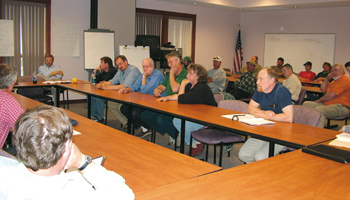Round Table On Groundfish
by Mike Crowe
|
Augusta, May, 30: Maine fishermen met with Maine Department of Marine Resources Commissioner George LaPointe in Augusta to discuss options for a new direction in groundfish management. The management policies that evolved out of the 1976 Magnuson-Stevens Act, long seen as inadequate, are being officially declared a failure.
After the GARM report (Groundfish Assessment Review Meeting) was released, Lapointe said he recalled looking at a proposed round of drastic cuts and realized the management plan was not working. Lapointe called for the meeting to get input from the industry to begin the process of structuring a management plan that might save, if not restore, a fishery with complex, long-term problems.
Influenced by international fisheries policies and politics, the first Magnuson-Stevens Act of 1976 sought a maximum sustained yield fisheries effort. Fishermen’s criticism of subsequent management policies began early and have been sustained over the decades. A few of these criticisms were expressed at the meeting, but overall a broader more forward looking position prevailed.
Present, and providing ideas, opinions and criticism, were a wide range of “stakeholders.” About 75 fishermen, buyers, processors, fleet owners, scientists, and managers talked about what they think is wrong with the system and what they think can fix it.
|

Fishermen talked about what a new groundfish management plan should and should not be with Department of Marine Resources Commissioner, George Lapointe in Augusta. The current plan widely considered a failure, is about to be replaced. The action coincides with the expected reauthorization of the Magnuson-Stevens Act. Photo: Fishermen's Voice |
|
|
|
|
Sit On The Gear
by Mike Crowe
|
Sloop boats were used for fishing and lobstering at least as far back as the 1870s. Many of these Maine-built boats were also used in Massachusetts. Offshore boats went to 40 feet, but most were about 28 feet with an open cockpit, fish hold and cuddy. Some had iron ballasted keels, but most carried stone ballast. The fast, easy-to-handle and seaworthy boats were “the” small fishing boat of their day.
A large number of sloops were built around Muscogus Bay. A couple of generations of the Morse family built sloop boats in Friendship, Maine and may in part be responsible for the sloop boat coming to be known as the Friendship sloop by the 1920s. Fishermen were beginning to use gasoline powered boats by this time and the sloops at the same time were becoming popular as yachts and sometimes called yacht sloops.
It’s tough to define just what a Friendship sloop is. Basically it’s a sloop boat and they varied according to the builder. Some were built by boat builders and others by fishermen and both put personal twists in their boats. They all had gaff rigged sails, raked stern, tumblehome and a built down keel.
Harold Burnham of Essex, Mass. fishes lobster out of a 28-foot sloop boat built in 1910 by Charles Morse. It still has its original bottom. Harold is a boat builder and designer who has built boats like the 19th century type 65-foot Gloucester fishing schooner Thomas Lannon in 1999; the Essex, an 18th century Chebego schooner as well as sloop boats. He builds them on the same piece of beach the first Burnhams built on in 1635.
continue
|
| The 1910 Friendship, Maine-built 28' sloop Chrissy, lobster fishing on its original bottom planks at Gloucester, Mass., August, 2001. |
|
|
|
|
|
  
|
|

